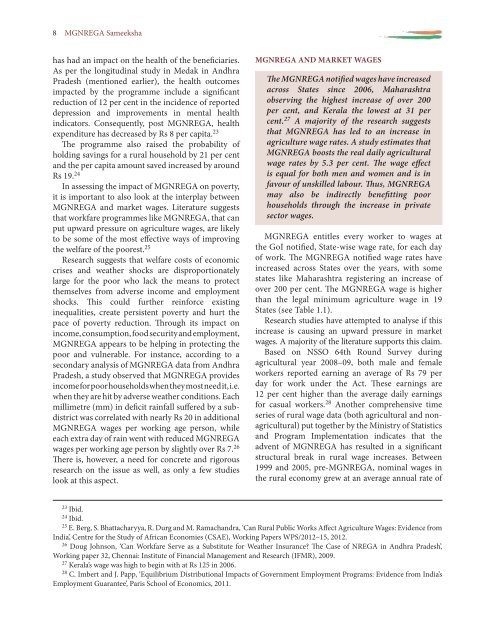MGNREGA_SAMEEKSHA
MGNREGA_SAMEEKSHA
MGNREGA_SAMEEKSHA
Create successful ePaper yourself
Turn your PDF publications into a flip-book with our unique Google optimized e-Paper software.
8 <strong>MGNREGA</strong> Sameeksha<br />
has had an impact on the health of the beneficiaries.<br />
As per the longitudinal study in Medak in Andhra<br />
Pradesh (mentioned earlier), the health outcomes<br />
impacted by the programme include a significant<br />
reduction of 12 per cent in the incidence of reported<br />
depression and improvements in mental health<br />
indicators. Consequently, post <strong>MGNREGA</strong>, health<br />
expenditure has decreased by Rs 8 per capita. 23<br />
The programme also raised the probability of<br />
holding savings for a rural household by 21 per cent<br />
and the per capita amount saved increased by around<br />
Rs 19. 24<br />
In assessing the impact of <strong>MGNREGA</strong> on poverty,<br />
it is important to also look at the interplay between<br />
<strong>MGNREGA</strong> and market wages. Literature suggests<br />
that workfare programmes like <strong>MGNREGA</strong>, that can<br />
put upward pressure on agriculture wages, are likely<br />
to be some of the most effective ways of improving<br />
the welfare of the poorest. 25<br />
Research suggests that welfare costs of economic<br />
crises and weather shocks are disproportionately<br />
large for the poor who lack the means to protect<br />
themselves from adverse income and employment<br />
shocks. This could further reinforce existing<br />
inequalities, create persistent poverty and hurt the<br />
pace of poverty reduction. Through its impact on<br />
income, consumption, food security and employment,<br />
<strong>MGNREGA</strong> appears to be helping in protecting the<br />
poor and vulnerable. For instance, according to a<br />
secondary analysis of <strong>MGNREGA</strong> data from Andhra<br />
Pradesh, a study observed that <strong>MGNREGA</strong> provides<br />
income for poor households when they most need it, i.e.<br />
when they are hit by adverse weather conditions. Each<br />
millimetre (mm) in deficit rainfall suffered by a subdistrict<br />
was correlated with nearly Rs 20 in additional<br />
<strong>MGNREGA</strong> wages per working age person, while<br />
each extra day of rain went with reduced <strong>MGNREGA</strong><br />
wages per working age person by slightly over Rs 7. 26<br />
There is, however, a need for concrete and rigorous<br />
research on the issue as well, as only a few studies<br />
look at this aspect.<br />
<strong>MGNREGA</strong> and Market Wages<br />
The <strong>MGNREGA</strong> notified wages have increased<br />
across States since 2006, Maharashtra<br />
observing the highest increase of over 200<br />
per cent, and Kerala the lowest at 31 per<br />
cent. 27 A majority of the research suggests<br />
that <strong>MGNREGA</strong> has led to an increase in<br />
agriculture wage rates. A study estimates that<br />
<strong>MGNREGA</strong> boosts the real daily agricultural<br />
wage rates by 5.3 per cent. The wage effect<br />
is equal for both men and women and is in<br />
favour of unskilled labour. Thus, <strong>MGNREGA</strong><br />
may also be indirectly benefitting poor<br />
households through the increase in private<br />
sector wages.<br />
<strong>MGNREGA</strong> entitles every worker to wages at<br />
the GoI notified, State-wise wage rate, for each day<br />
of work. The <strong>MGNREGA</strong> notified wage rates have<br />
increased across States over the years, with some<br />
states like Maharashtra registering an increase of<br />
over 200 per cent. The <strong>MGNREGA</strong> wage is higher<br />
than the legal minimum agriculture wage in 19<br />
States (see Table 1.1).<br />
Research studies have attempted to analyse if this<br />
increase is causing an upward pressure in market<br />
wages. A majority of the literature supports this claim.<br />
Based on NSSO 64th Round Survey during<br />
agricultural year 2008–09, both male and female<br />
workers reported earning an average of Rs 79 per<br />
day for work under the Act. These earnings are<br />
12 per cent higher than the average daily earnings<br />
for casual workers. 28 Another comprehensive time<br />
series of rural wage data (both agricultural and nonagricultural)<br />
put together by the Ministry of Statistics<br />
and Program Implementation indicates that the<br />
advent of <strong>MGNREGA</strong> has resulted in a significant<br />
structural break in rural wage increases. Between<br />
1999 and 2005, pre-<strong>MGNREGA</strong>, nominal wages in<br />
the rural economy grew at an average annual rate of<br />
23<br />
Ibid.<br />
24<br />
Ibid.<br />
25<br />
E. Berg, S. Bhattacharyya, R. Durg and M. Ramachandra, ‘Can Rural Public Works Affect Agriculture Wages: Evidence from<br />
India’, Centre for the Study of African Economies (CSAE), Working Papers WPS/2012–15, 2012.<br />
26<br />
Doug Johnson, ‘Can Workfare Serve as a Substitute for Weather Insurance? The Case of NREGA in Andhra Pradesh’,<br />
Working paper 32, Chennai: Institute of Financial Management and Research (IFMR), 2009.<br />
27<br />
Kerala’s wage was high to begin with at Rs 125 in 2006.<br />
28<br />
C. Imbert and J. Papp, ‘Equilibrium Distributional Impacts of Government Employment Programs: Evidence from India’s<br />
Employment Guarantee’, Paris School of Economics, 2011.


